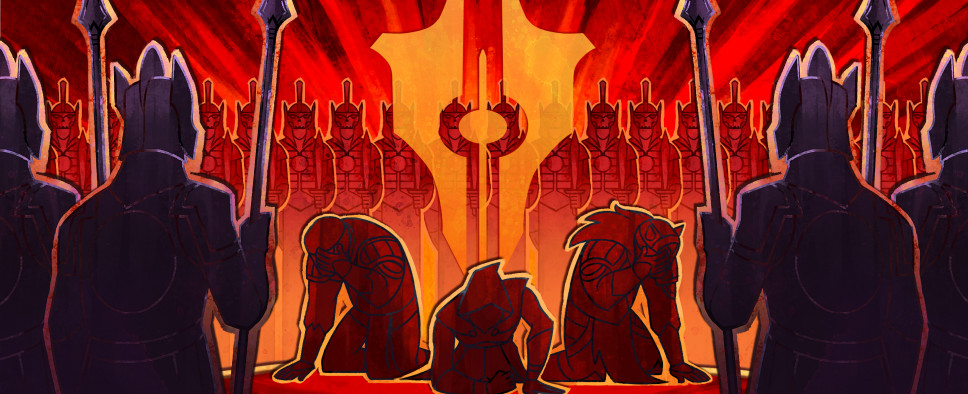Tyranny E3 2016 Previews and Gameplay Footage
-
Category: News ArchiveHits: 1817

Journalists who attended E3 had the chance to get their hands on Tyranny, Obsidian Entertainment and Paradox Interactive's real-time with pause RPG set in a world where "evil won." While there are plenty of impressions to cover, I'm going to start by embedding 36 minutes of footage that were recorded by the folks at PCGamesN, given gameplay speaks louder than a thousand words.
Some of the UI and animation changes look like they will solve a lot of problems with readability in combat that were present in Pillars of Eternity, which just happened to be one of my main pet peeves with the crowdfunded title:
PCGamesN also has a full write-up with some words from director Brian Heins. A sampling:
Conversation and combat, the meat and potatoes of Tyranny, are immediately familiar from Pillars. Chat boxes contain not just dialogue but literary flourishes and descriptive asides - the behavioural cues that help guide your choices. Frequently there are four or five response options, some tied to specific stats or past decisions and allegiances.
When negotiation does break down, the fighting is as involved and intricate as ever. The violent exchanges I had with the Disfavored - one elite legion within Kyros’ diverse and squabbling army - felt lengthy and gruelling, especially since they necessitated plenty of pausing via the space bar to issue orders and fire off spells. Magical abilities are still very much at play in this realm, and Obsidian have introduced combos - powers that require the cooperation of two specific party members to pull off.
Companions are picked up Pillars-style out in the world, and combos help narrow the gulf between the decisions you make about your characters and the ones you make during combat. They’re triggered like spells and other cooldown abilities - but the combos you have available are defined by which companions you have and how you treat them.
From the start, Obsidian made it clear my experience wouldn’t necessarily be the same as every other person at E3. They’d actually brought three demos to the show.
Not three separate sections, though. Rather, this was the same battle—over a citadel known as Ascension Hall—but with different allegiances. Your protagonist in Tyranny, an agent of the law known as a Fatebinder, is part of and yet separate from every faction in the game. As such, you can go into the battle for Ascension Hall aligned with any of three groups: The Rebels, the Scarlet Chorus, or the Disfavored.
I was paired with the Rebels, who are actually in possession of the citadel at the demo’s start—besieged by both the Scarlet Chorus and the Disfavored. Through some political machinations I’d managed to spark some infighting amongst the Chorus and Disfavored, but they’d finally gotten their wits about them and were about to launch an all-out assault.
I could just as easily have been aligned with the Chorus or the Disfavored, each of which has its own reasons for assaulting Ascension Hall—or rather, the same reason but in conflict with each other. Each leader wants the glory from capturing the citadel and returning it to the supreme leader Kyros.
I was working with a party of four—fewer than Pillars' six-person standard—which gives my party greater focus, and makes the roles of each member more important. Realtime-with-pause party combat returns, but this time in a much more readable form. Pillars had a decent tactical combat system, but forced players to go digging to discover important combat mechanics. Tyranny is much clearer. Once you've queued up a warrior's shield bash a circular timer above their head lets you know exactly when the move will be executed. The free disengagement hits adventurers get when an enemy moves out of combat are now clearly signposted and the UI has been revamped to make character skills easier to access.
Once again, different classes' skills and spells interweave with other party members' abilities. Tanks can taunt to refocus nearby enemies on him, allowing for rogue types to land their specialist high-damage flanking attacks. This time characters can act with even greater synergy using co-op attacks. In my party my rogue can activate a skill that trips an enemy, causing my warrior to automatically run over and punch the downed enemy in the chest. The blow is savage enough to cause bleeding damage, but it's also a fine way to interrupt a spellcaster. Interrupts again form an important part of the combat system. Shield-bashing and chest-punching mages is a fun way to take them out of the fight.
The UI seems much more user friendly in general and looks suspiciously designed for compatability with consoles. This is very interesting and leads me to believe that there may be a console port of the game some time next year. When we asked about a possible console port, Tyranny Producer Matthew Singh gave a slight smile and said that they had looked into it, but couldn’t talk about it. It will be very interesting to see if there are any developments along this front as this is the type of game t hat could find a following on consoles, similar to Divinity Original Sin.
Abilities now no longer have a fixed number of uses per encounter, but instead have cooldowns. This really is a great change for the players. As those familiar with Pillars of Eternity will tell you, it was difficult to manage your abilities and frustrating when you ran out of ones you really needed. This will also keep the combat interesting in longer fights. Previously, in longer battles of attrition, you would likely blow most or all your abilities before the encounter was complete, making the last portions of battle more about auto attacking and less about using your interesting and carefully planned abilities. Now you can enter an encounter with a full arsenal and can plan your attack from start to finish in a gratifying fashion.

